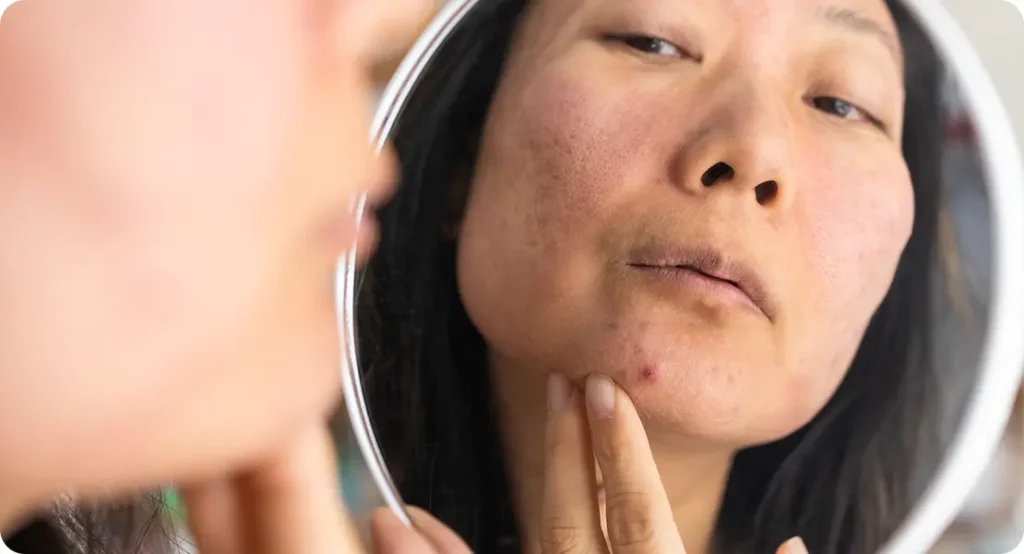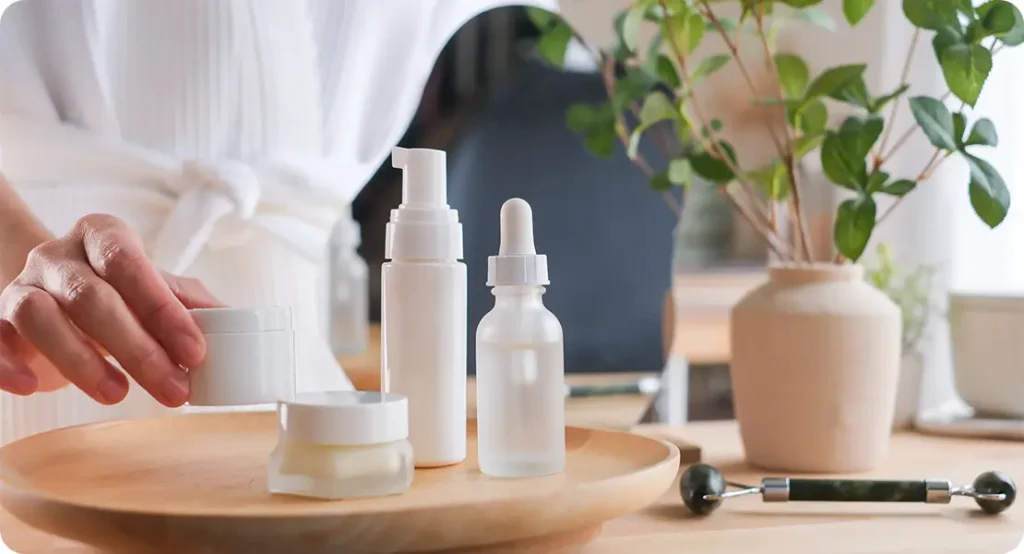If you thought acne was just a teenage problem, you’re not alone but you’re also not entirely right. Many people are surprised (and frustrated) to find themselves battling breakouts well into adulthood. In fact, adult acne is a growing concern affecting people in their 20s, 30s, 40s, and even 50s. It’s not just the occasional spot before an important meeting or social event some adults deal with persistent, recurring acne that impacts not only their skin, but also their confidence and overall well-being.
The truth is, adult acne isn’t just a leftover from your teenage years. It often has different triggers than adolescent breakouts and may require a different approach to treatment. From fluctuating hormones and chronic stress to unsuitable skincare products and dietary factors, a range of culprits can contribute to adult acne. The good news? With the right knowledge and care, it can be managed effectively.
What makes adult acne especially frustrating is that it often appears alongside other skin concerns like fine lines, dryness, or pigmentation making treatment a balancing act. You can’t always use the same harsh products you relied on as a teen, because adult skin tends to be more sensitive and complex. That’s why it’s so important to understand not just what causes these breakouts, but also how to treat them in a way that supports your skin’s overall health.
Whether you’re experiencing mild flare-ups or a chronic struggle, understanding what’s behind your breakouts is the first step toward getting clearer skin. Let’s take a closer look at why adult acne happens and more importantly, what really works to keep it under control.
1. Adult Acne Is Real and More Common Than You Think

Think acne is something you left behind in high school? Not quite. More than 40% of adults continue to experience acne well beyond their teenage years, and for some, it’s a brand-new issue that starts in their 20s or even later. Unlike teenage acne, adult breakouts often feel more stubborn and unpredictable and they can have just as big an impact on self-esteem.
While both men and women can develop adult acne, women are more frequently affected, especially due to hormonal changes tied to:
- Menstrual cycles
- Pregnancy or postpartum shifts
- Perimenopause and menopause
- Hormonal conditions like PCOS
One of the most frustrating aspects of adult acne is that it can pop up for a wide range of reasons, many of which overlap or evolve over time. These may include:
- Chronic stress, which increases cortisol and oil production
- Poor sleep, which can disrupt hormone balance and skin regeneration
- High-glycaemic diets, such as those heavy in sugar and refined carbs
- Dairy consumption, particularly skimmed milk, which some studies link to breakouts
- Medication side effects, including corticosteroids, certain antidepressants, or hormonal birth control changes
- Aggressive or unsuitable skincare routines, especially over-cleansing or using drying products
- Environmental factors, like pollution or constant mask-wearing (aka “maskne”)
You may also notice that the location of adult acne is different from the typical T-zone spots of your teenage years. Adult breakouts commonly show up:
- Along the jawline and chin
- On the neck and lower cheeks
- Occasionally on the back or chest
Understanding that adult acne is both real and common is an important first step it helps remove the stigma and encourages a more strategic, science-backed approach to treatment.
2. Hormones Often Play a Huge Role
When it comes to adult acne, hormonal fluctuations are one of the most common and powerful triggers especially for women. Shifts in hormone levels can stimulate oil production, increase inflammation, and disrupt the skin’s natural balance, all of which can lead to breakouts.
Hormonal acne is typically linked to changes in levels of androgens, a group of hormones that includes testosterone. Androgens ramp up the activity of sebaceous (oil) glands in the skin. The result? More oil, more clogged pores, and more opportunities for acne-causing bacteria to thrive. This type of acne often presents as deep, painful cysts, particularly around the jawline, chin, and neck.
Here are some key life stages and conditions where hormones can trigger or worsen acne:
- Monthly menstrual cycles – Many women notice breakouts in the week leading up to their period.
- Pregnancy – Hormonal surges in the first and second trimesters can lead to unexpected flare-ups.
- Polycystic ovary syndrome (PCOS) – A hormonal disorder that often causes chronic acne, irregular periods, and excess facial hair.
- Perimenopause and menopause – Shifting oestrogen and progesterone levels can reactivate acne even in women who haven’t broken out in years.
- Stopping or starting birth control – Hormonal contraception can either stabilise or worsen acne, depending on the type and your body’s response.
Signs of hormonal acne often include:
- Breakouts that worsen around the same time each month
- Deep, tender cysts that don’t come to a head
- Pimples concentrated on the lower face
- Acne that resists conventional topical treatments
If this sounds like your situation, you’re not imagining things and topical creams alone might not be enough. Identifying and treating the hormonal root cause can make all the difference.
3. Skincare Products Might Be Making Things Worse

Believe it or not, the very products you’re using to clear your skin might actually be causing more harm than good. Many adults with acne unknowingly reach for harsh exfoliants, alcohol-based toners, or rich creams that can strip the skin’s barrier or clog pores making breakouts worse over time.
When your skin feels oily or congested, it’s tempting to go in with aggressive treatments. But over-cleansing or over-exfoliating can lead to irritation, dryness, and a rebound effect where your skin produces even more oil to compensate. On the flip side, using overly rich products or pore-clogging ingredients can smother the skin and trigger comedones.
Here are some common skincare missteps that can worsen adult acne:
- Using harsh scrubs or cleansers that strip natural oils
- Overusing active ingredients like retinoids or AHAs without balancing hydration
- Layering too many heavy creams or oils, especially if they contain comedogenic ingredients
- Skipping moisturiser altogether, which can lead to dehydrated skin that overproduces oil
- Relying on makeup with pore-clogging formulas, particularly silicone-heavy or long-wear types
- Not thoroughly removing sunscreen or makeup at the end of the day
To support acne-prone adult skin, look for products that are:
- Non-comedogenic – meaning they won’t clog pores
- Fragrance-free or low-fragrance – to reduce irritation
- Gentle and pH-balanced – especially cleansers that won’t disrupt your barrier
Targeted with effective ingredients, such as:
- Salicylic acid – to unclog pores and reduce inflammation
- Niacinamide – to calm redness and regulate oil
- Azelaic acid – to target both acne and pigmentation
- Lightweight moisturisers – to keep skin hydrated without heaviness
Consistency is key. Sometimes, simplifying your skincare routine is the most powerful move you can make.
4. Stress and Lifestyle Habits Have a Direct Impact
You might think stress is just something you “feel,” but your skin definitely feels it too. Chronic stress can wreak havoc on your skin by disrupting your hormones and increasing inflammation. When you’re stressed, your body releases cortisol, a hormone that tells your sebaceous (oil) glands to ramp up production. More oil + more inflammation = a perfect recipe for breakouts.
And it’s not just emotional stress lifestyle habits play a major role in how your skin behaves. Skipping your skincare routine after a long day, staying up too late, eating poorly, or even constantly touching your face without realising can all make acne worse over time.
Here’s how stress and daily habits can contribute to adult acne:
- Increased cortisol levels stimulate oil glands and inflammation
- Poor sleep disrupts your skin’s overnight repair process
- Touching your face frequently transfers bacteria and dirt
- Wearing tight hats, helmets, or face masks can trap sweat and oil (aka “acne mechanica”)
- High-sugar, highly processed diets may cause spikes in insulin and inflammation
- Skipping cleansing or inconsistent skincare leads to buildup of oil, bacteria, and dead skin cells
On the flip side, managing stress effectively can be surprisingly powerful in keeping your skin clearer and calmer. Small lifestyle changes can make a big difference, such as:
- Prioritising 7–9 hours of quality sleep each night
- Exercising regularly to help regulate hormones and reduce inflammation
- Practising mindfulness or meditation, even just 5–10 minutes daily
- Eating a balanced diet rich in anti-inflammatory foods like leafy greens, omega-3s, and berries
- Keeping your hands off your face, and cleaning phones and pillowcases regularly
While stress may not be the only cause of your breakouts, learning to manage it is an essential part of a well-rounded acne treatment plan.
5. Diet Matters More Than We Used to Think

For years, the connection between food and acne was dismissed as a myth. But newer research has shown that diet can influence skin health, especially in those already prone to breakouts. While food isn’t usually the sole cause of adult acne, it can be a trigger or aggravator and making the right dietary changes might just help calm your skin.
The biggest culprits? High-glycaemic index (GI) foods and dairy products. High-GI foods cause rapid spikes in blood sugar, which can lead to increased insulin levels. This, in turn, stimulates oil production and inflammation two things acne-prone skin doesn’t need more of. Some studies have also found a correlation between dairy (particularly skim milk) and acne, possibly due to hormones present in milk or its impact on insulin levels.
Here are some foods and habits that may trigger breakouts in some individuals:
- Refined carbs and sugars – white bread, pastries, sugary drinks, sweets
- Dairy products, especially skimmed milk and ice cream
- Processed and fried foods – which can increase inflammation
- Whey protein supplements – often linked to breakouts in athletes
- Excess caffeine or alcohol, which can dehydrate and stress the skin
Helpful dietary habits for clearer skin include:
- Switching to low-GI foods – like oats, sweet potatoes, and whole grains
- Eating anti-inflammatory foods – such as leafy greens, berries, avocados, and fatty fish
- Staying hydrated – to help your body flush out toxins and maintain healthy skin function
- Limiting added sugars – including those in sauces, drinks, and “healthy” snacks
- Watching portion sizes and overall balance – overloading any food group can throw your system off
To better understand how your skin responds to certain foods, try this:
- Keep a food and skin journal for a few weeks
- Note what you eat and track any changes in breakouts
- Experiment with eliminating dairy or high-sugar foods for 2–4 weeks and see how your skin reacts
Everyone’s skin is different, so there’s no one-size-fits-all diet but if you’re struggling with adult acne, what you put on your plate might be just as important as what you put on your face.
6. Treatments Must Be Tailored for Adults
Unlike teenage acne, adult acne tends to be more complex and often more resistant to basic over-the-counter treatments. While drugstore spot treatments might help with occasional pimples, persistent or cystic adult acne usually requires a more tailored, long-term approach.
The key is recognising that adult skin has different needs. Many adults are dealing with a mix of concerns acne, fine lines, sensitivity, or dryness which means treatments must strike a balance: effective, but not overly harsh.
Most adults benefit from a combination approach, which may include both topical and oral medications. Here are some commonly recommended treatment options:
Topical Treatments:
- Retinoids (e.g., adapalene, tretinoin) – help unclog pores, reduce inflammation, and improve cell turnover
- Benzoyl peroxide – targets acne-causing bacteria and reduces inflammation
- Azelaic acid – ideal for sensitive skin, tackles both acne and pigmentation
- Niacinamide – calms redness and regulates oil without irritation
- Salicylic acid – exfoliates inside pores to prevent buildup
Oral Treatments (prescription only):
- Antibiotics (e.g., doxycycline, minocycline) – short-term use for moderate to severe acne
- Hormonal therapies (e.g., spironolactone or birth control pills) – regulate hormones in women with hormonally driven acne
- Isotretinoin (Accutane) – for severe, treatment-resistant acne (used under strict medical supervision)
It’s also worth noting that adult acne isn’t just about treatment it’s about personalisation. The same product that works for a teenager or your friend may not work for you, especially if you have sensitive or combination skin.
That’s why seeing a qualified dermatologist is a game-changer. A specialist can:
- Evaluate your skin type and acne severity
- Identify whether hormonal issues are contributing
- Rule out underlying conditions (e.g., PCOS or rosacea)
- Build a skincare routine that supports both acne control and skin health
- Monitor side effects and adjust your plan as needed
Trying to tackle adult acne alone can be frustrating and time-consuming. A personalised plan makes all the difference bringing faster, longer-lasting results.
Final Thought: Don’t Let Adult Acne Go Untreated
Dealing with breakouts as an adult can feel frustrating and disheartening especially when nothing seems to work. But the good news is, you don’t have to live with it or settle for cover-ups. Whether your acne is hormonal, stress-related, or triggered by lifestyle habits, targeted treatment is possible and effective.
If your acne is painful, persistent, or leaving scars, it’s time to seek expert help. The earlier you intervene, the better your chances of preventing long-term skin damage.
Book a consultation at our London acne clinic to explore treatment options tailored to your skin’s needs.
FAQs:
- Why am I still getting acne in my 30s or 40s?
Adult acne is often triggered by hormonal fluctuations, stress, certain medications, or lifestyle habits. Unlike teenage acne, it commonly appears around the jawline and chin and can persist for years without proper treatment. - Can skincare products cause or worsen adult acne?
Yes. Products with pore-clogging (comedogenic) ingredients, harsh cleansers, or heavy oils can irritate the skin and trigger breakouts. Opt for non-comedogenic, gentle formulations with ingredients like salicylic acid or niacinamide. - What’s the best way to treat adult acne?
The most effective treatment plans are customised. They may include topical treatments (like benzoyl peroxide or retinoids), oral medications (like antibiotics or hormonal therapy), and lifestyle changes. Consulting a dermatologist ensures you get a targeted, effective approach.
References:
- Collier, C.N., Harper, J.C., Cafardi, J.A. et al. (2008)
‘The prevalence of acne in adults 20 years and older’, Journal of the American Academy of Dermatology, 58(1), pp. 56–59. https://www.jaad.org/article/S0190-9622(07)01081-X/abstract - Tan, J.K.L. and Bhate, K. (2015)
‘A global perspective on the epidemiology of acne’, British Journal of Dermatology, 172(S1), pp. 3–12. https://onlinelibrary.wiley.com/doi/full/10.1111/bjd.13462 - Perkins, A.C., Maglione, J., Hillebrand, G.G. et al. (2018)
‘Adult female acne: A retrospective analysis of potential risk factors’, Journal of Clinical and Aesthetic Dermatology, 11(1), pp. 21–26. https://www.ncbi.nlm.nih.gov/pmc/articles/PMC5798558/ - Dreno, B., Thiboutot, D., Gollnick, H. et al. (2022)
‘Pathophysiology and management of adult female acne: A review’, Cosmetics, 11(3), 74. https://www.mdpi.com/2079-9284/11/3/74 - Zaenglein, A.L., Pathy, A.L., Schlosser, B.J. et al. (2016)
‘Guidelines of care for the management of acne vulgaris’, Journal of the American Academy of Dermatology, 74(5), pp. 945–973.e33. https://www.jaad.org/article/S0190-9622(15)02614-6/fulltext
